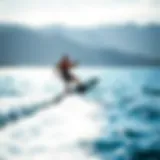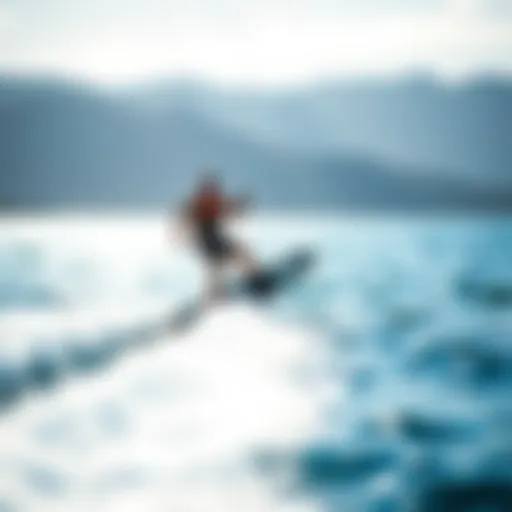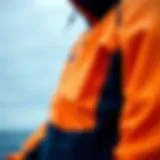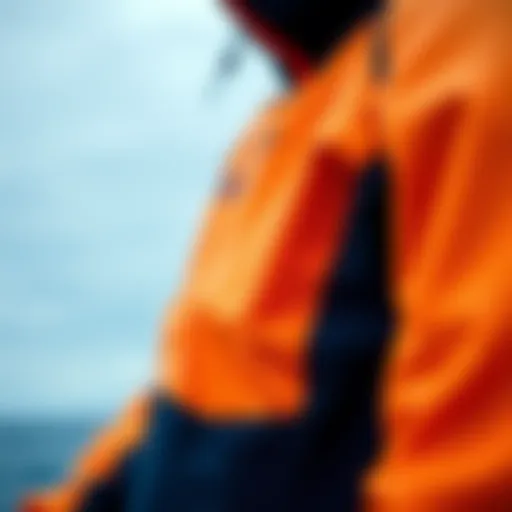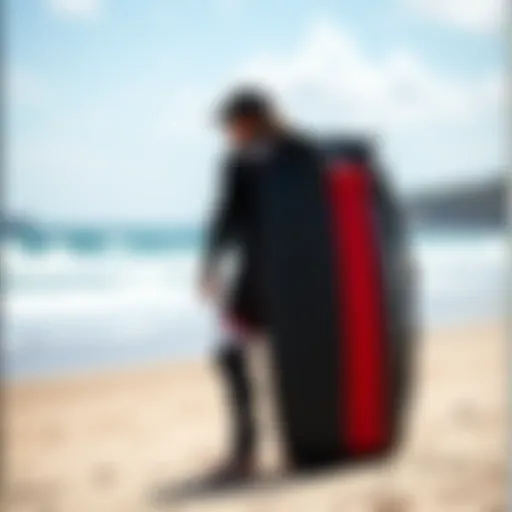The Essential Guide to Buying Used Kitesurfing Gear
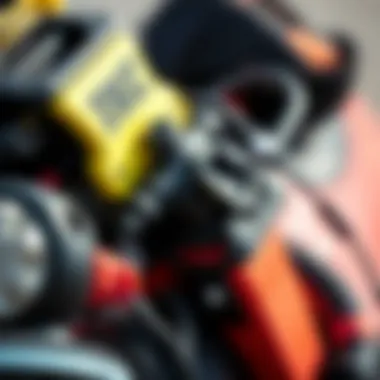
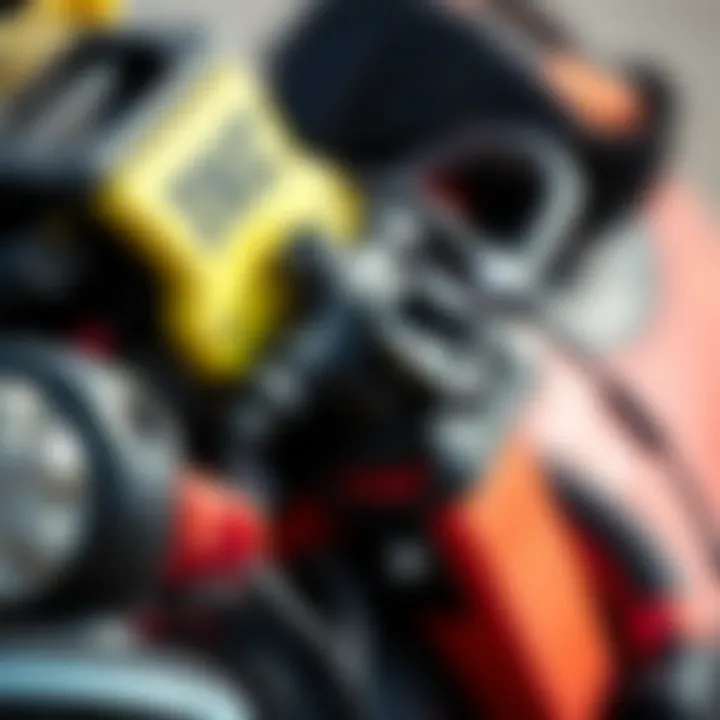
Intro
Purchasing used kitesurfing equipment can feel like wading through uncharted waters. Herein lies the adventure as you source gear that provides the thrill of the ride without the hefty price tag. To make sense of this vast landscape, it’s crucial to understand not just what to buy, but also the nuances of the equipment’s lifecycle, its condition, and what to look for when making informed decisions.
Kiteboarding, while exhilarating, has its share of risks and challenges. The gear you choose plays a significant role in your safety and performance on the water, be it a sturdy kite, a reliable board, or durable harness. Buyers often find themselves juggling between choosing between a brand new model or venturing into the domain of pre-owned equipment, often leading to the conclusion that understanding the ins-and-outs of used gear brings both opportunities and pitfalls.
This guide aims to paint a clear picture on the topic, addressing all the essential elements from gear evaluation to maintenance practices. As we navigate through each section, you’ll find useful insights and tips to help you sail through the kitesurfing marketplace with confidence.
"The ocean is a splendid teacher, and kitesurfing opens its chapters."
By keeping a keen eye on the details, you can find quality gear that enhances your experience rather than hindering it. We will also touch upon market trends that can help shed light on future purchases, ensuring you stay one step ahead in your kiteboarding journey.
Intro to Used Kitesurfing Equipment
In the world of kitesurfing, gear plays a pivotal role in shaping one’s experience on the water. However, purchasing new equipment can often burn a hole in one’s pocket, not to mention the constant evolution in technology that makes previous models feel outdated shortly after release. This is where used kitesurfing equipment enters the picture, opening doors to affordability and accessibility without sacrificing quality.
Understanding the ins and outs of pre-owned gear can not only enhance your kitesurfing experience but also save quite a bit of cash. Whether you’re a newbie looking for your first setup or a seasoned rider wanting to upgrade your gear, exploring the market for second-hand options can yield surprising benefits. In this section, we will dive into the nuts and bolts of used equipment, breaking down the complexities so buyers can feel confident in their selections.
Understanding Kitesurfing Gear
At its essence, kitesurfing gear consists of several key components: kites, boards, harnesses, lines, and control bars. Each piece plays a distinct role in the overall functionality of your ride. Kites can be classified into various types, such as inflatable or foil kites, each possessing unique characteristics that affect performance in different wind conditions. Boards come in multiple shapes—directional or twin-tip—impacting maneuverability, stability, and speed.
Harnesses are equally crucial, as they connect the rider to the kite, and choosing the right fit can improve comfort and control. The lines and bar serve as the vital link between them, allowing the rider to control the kite’s power and direction. Understanding these components will help you make informed decisions when evaluating used equipment.
The Appeal of Used Equipment
The allure of buying used kitesurfing equipment is hard to overlook. First, it’s substantially cheaper than new gear. In a sport where prices can soar, snagging a good deal on pre-owned items opens up opportunities for riders who might otherwise shy away from investing in high-quality gear.
Moreover, purchasing used gear often grants access to higher-end models that might be out of reach otherwise, making it possible to experience advanced technology without breaking the bank. Plus, there’s a certain satisfaction in hunting down a unique piece of equipment that has its own story, a character that brand-new items simply lack.
"The thrill of kitesurfing lies not just in the ride, but in the community and the stories tied to each piece of gear."
In summary, the charm of used kitesurfing gear is woven from threads of affordability, accessibility, and the charm of character. By understanding both the components of kitesurfing gear and the reasons behind the growing appeal of used equipment, aspiring kiteboarders can confidently navigate the sometimes murky waters of second-hand purchases.
Key Components of Kitesurfing Equipment
When it comes to kitesurfing, having the right equipment can make the difference between an exhilarating ride and a frustrating day on the water. Understanding the key components of kitesurfing gear is essential for anyone looking to jump into the sport or upgrade their setup. This section aims to break down the various elements that make up kitesurfing equipment, highlighting the benefits and considerations associated with each category.
Kites: Types and Features
Kites are, without a doubt, the heart of kitesurfing. They come in different designs, each tailored for various conditions and riding styles.
Foil Kites
Foil kites are known for their aerodynamic shape and ability to perform efficiently in lighter winds. These kites have a robust frame made of several cells that allow air to flow through, creating lift. One of their distinct advantages is their ability to stay aloft even in challenging air conditions. . With the right techniques, a rider can glide smoothly over the water with minimal power input, making foil kites a popular choice for those who want to explore long-distance kitesurfing.
However, one downside is the learning curve. They can be less forgiving for beginners who might struggle with control, especially in gusty winds.
Inflatable Kites
Inflatable kites are perhaps the most widely recognized type of kitesurfer's weapon. Their design features inflatable bladders that create a rigid structure. The key selling point of inflatable kites is their versatility and ease of use. They perform well in a variety of wind conditions and are ideal for jumpers looking to get airtime.
A unique feature is how forgiving they are in terms of crashes; when they hit the water, they generally float, allowing for easier retrieval. However, they are bulkier to transport due to the need to inflate and deflate.
Hybrid Kites
Hybrid kites, as the name implies, blend features from both foil and inflatable kites. This makes them a versatile option for kiteboarders who want the best of both worlds. They often combine the stability of inflatable kites with the efficiency of foils.
For many, this results in better performance across a wide range of wind conditions, allowing riders to experience more flexibility. On the flip side, finding specific hybrid models can sometimes be tricky, especially if you’re after a particular brand or size.
Boards: Selecting the Right Type
Next up is the board. The type of board you choose can significantly impact your experience on the water, affecting how you ride and the tricks you can accomplish.
Directional Boards
Directional boards are tailored for those who prefer riding in one direction. They are commonly used in wave riding, as their shape allows for better control and responsiveness on the water. A characteristic feature is the pronounced rocker, which helps in carving through choppy water and makes navigating waves easier.
This type of board shines when it comes to performance in waves but may not be the best option for complete beginners who may need more versatility in their riding style.
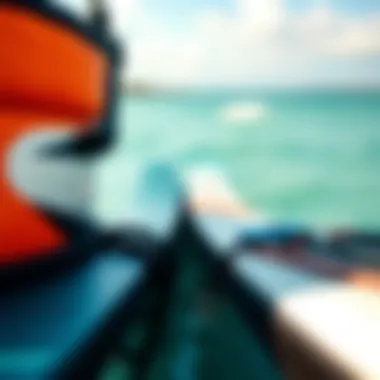
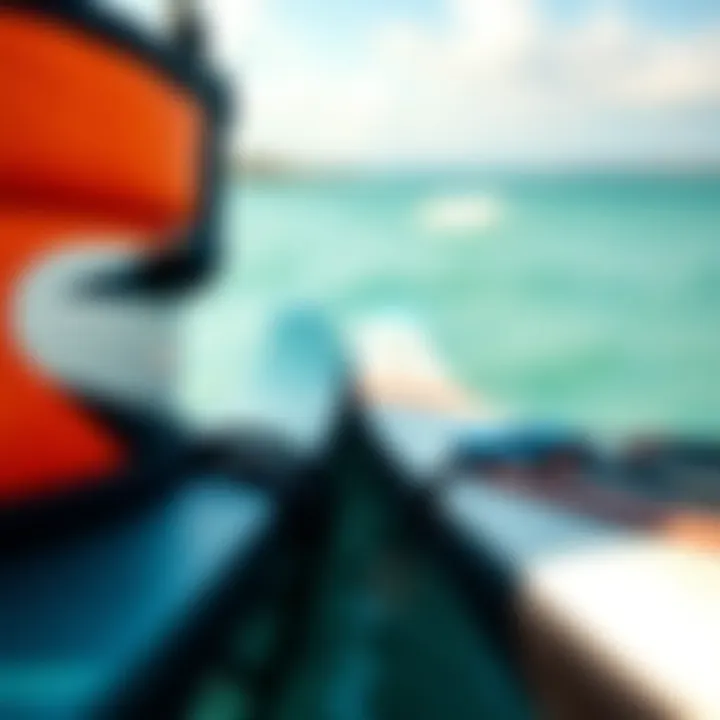
Twin-Tip Boards
In contrast, twin-tip boards are designed to be symmetrical, allowing for riding in either direction, which makes them extremely popular among freestyle enthusiasts. The northward-catching edge enhances jumps and tricks. The ease with which a rider can switch stances makes them the go-to option for many newcomers and seasoned pros alike.
However, some riders may find them less stable in high-wind conditions, which could affect performance stability.
Foil Boards
Foil boards are quite the thing in the kitesurfing community these days. They feature an underwater foil that lifts the board above the water's surface, providing a unique riding experience. This design allows for unparalleled speed and smoothness in flatwater conditions.
One distinct advantage is how they allow riders to engage even with lighter winds; it’s like flying on water! But, they require a good deal of balance and control, often making them better suited for experienced riders.
Harnesses: Finding the Perfect Fit
Comfort during your sessions often comes down to harness choice, as this equipment is crucial for distributing pull.
Wake Harnesses
Wake harnesses are generally broader and provide more support. They allow for a better hookup when catching air, invaluable for riders looking to perform tricks and jumps. However, some may find the design restrictive, especially during extended sessions.
Seat Harnesses
For those prioritizing comfort, seat harnesses can be a safer bet. They sit lower on the body and help distribute the kite’s pull across the waist and legs, which can alleviate pressure on the lower back during long rides. Some may worry that they lack the high performance found in other harness types, but for leisurely cruising or beginners, they are often the ideal choice.
Hip Harnesses
Hip harnesses offer a balanced approach. They sit higher than seat harnesses but lower than wake harnesses, providing great freedom of movement while still offering decent support. This makes them versatile. But, they can shift during extreme maneuvers, which might be a downside for some riders.
Lines and Bar: Essential Controls
Finally, the lines and bar form the link between the rider and the kite, so their importance cannot be overstated.
Line Materials
Line materials vary widely, from high-strength Dyneema to more amateur-friendly options. Using quality lines can significantly impact your kiting experience. They should offer good resistance to abrasion and stretching. However, lower-end materials may fray over time and could let down performance.
Bar Sizes
Having the right bar size is crucial. A larger bar can provide better control for big kites, while smaller bars are often preferred when flying smaller kites. Picking the proper bar can vastly improve response time and handling. Yet, choosing the wrong size could lead to uncomfortable setups and poor control.
Safety Features
Lastly, safety features are paramount in any kitesurfing setup. Look for quick-release mechanisms and safety leashes that are both user-friendly and reliable. These aspects can be lifesavers in unpredictable circumstances. However, features that are overly complex might hinder quick actions, potentially putting safety on the back burner.
Choosing the right combination of gear can enhance both your comfort and performance, making for a more enjoyable kitesurfing experience.
Evaluating Used Kitesurfing Equipment
When it comes to kitesurfing, the right gear can make all the difference between a thrilling day on the water and a humdrum experience. Evaluating used kitesurfing equipment is crucial for ensuring that the gear you choose meets both your performance needs and your safety standards. Whether you're a seasoned kiteboarder or just starting, understanding the assessment process will guide you toward making wise purchases that won’t empty your wallet.
Inspecting Kites for Damage
A kite is the heart and soul of your kitesurfing experience. When evaluating a used kite, the first thing that should catch your eye is its physical condition. Look for visible signs of deterioration. This includes:
- Tears or punctures: Check leading edges, seams, and the canopy fabric itself carefully. Small holes might be repairable, but larger cuts could compromise performance significantly.
- Color fading: While this might seem cosmetic, excessive fading might indicate prolonged exposure to sunlight, potentially affecting the material's strength.
- Worn bridle lines: Inspect the bridle lines and check for fraying. They need to be in sound condition because they are crucial for controlling the kite.
Don't shy away from giving the kite a good pull. Make sure it holds its shape; if it looks misshapen or flimsy, it might just be past its prime.
Assessing Board Condition
Next on the list is the board, an equally vital component. When evaluating a used kitesurfing board, consider these factors:
- Dents and scratches: Look for any deep dents in the rail or bottom. Minor scratches can be overlooked, but significant damage could lead to water infiltration, which will make your board heavy and degrade its integrity over time.
- Footstrap wear: Inspect the condition of the footstraps. If they feel brittle or show signs of serious wear, they may need to be replaced sooner rather than later.
- Fin attachment points: Check that the fins can be securely fastened. Loose fin mounts can prevent proper control while navigating.
Remember, when it comes to boards, a little wear often indicates experience rather than a deal-breaker. Just be judicious about the extent of the wear.
Harness Integrity and Comfort
A good harness should envelop you like a warm hug, but with enough support to keep you in control as you tackle the waves. Look for:
- Adjustability: Check for any signs of wear on the adjustment straps and buckles. These should operate smoothly and lock securely in place.
- Padding condition: Your harness should have adequate padding. If the padding feels flattened or has started coming apart, it might be time to look elsewhere.
- Overall fit: When trying on a harness, ensure it hugs your body without cutting off circulation or feeling like it's slipping away. Comfort is key here, as a good harness can help you stay focused on mastering your technique rather than wrestling with your gear.
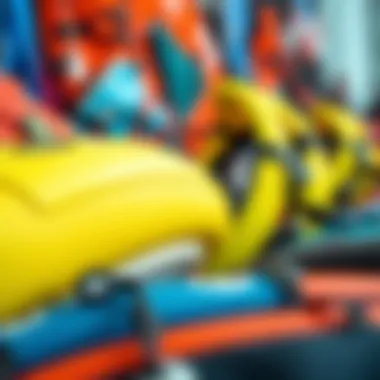
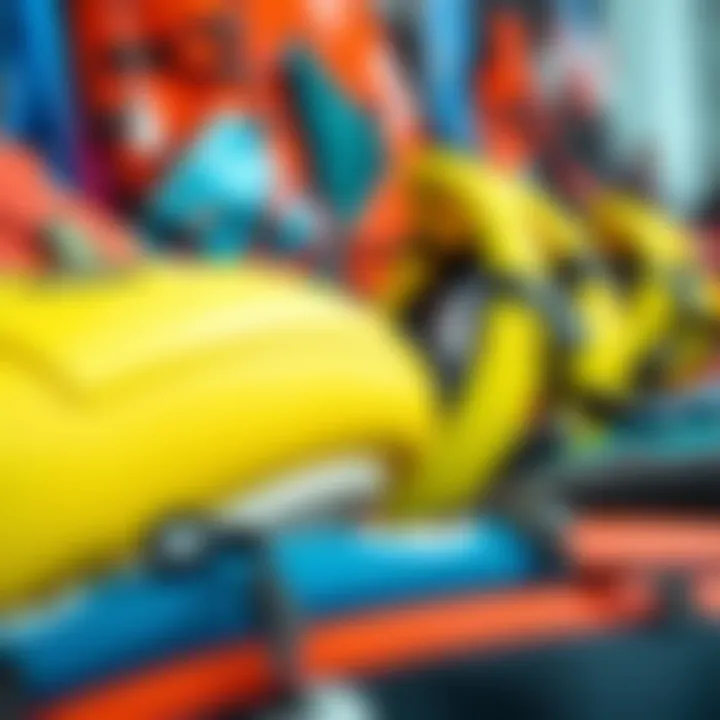
Lines and Bar Maintenance
The efficacy of the kite depends significantly on its control system, including the lines and the bar. Here's what to inspect:
- Line symmetry: Make sure that all lines are even. An asymmetrical setup can ruin your fly and drive you in circles, literally.
- Material checks: Examine the lines for frays, excessive stretching, or discoloration. If they're showing wear and tear, it could lead to failure at critical moments.
- Bar condition: Check that the bar spins freely and that the safety release mechanism functions properly. An easy-to-use safety system could be a lifesaver.
Maintaining these components can greatly improve your kitesurfing experience. It's essential to be thorough in your evaluation, as these elements play a vital role in your time on the water.
Remember, every used piece of gear tells a story. Evaluate each item based on its condition, history, and your own kitesurfing needs, and you’ll be set to ride the waves more confidently.
Advantages of Buying Used Equipment
When it comes to kitesurfing, investing in equipment can often feel daunting, especially with the prices of new gear sometimes leaving a considerable dent in one’s wallet. Enter the perspective of purchasing used kitesurfing equipment—a practical approach that brings multiple benefits to the table. This part highlights why opting for pre-owned gear can be a wise decision, not just for your finances but also for access to premium products and the impact on the environment.
Cost-Effectiveness
One of the foremost advantages of buying used kitesurfing gear is undoubtedly the cost-effectiveness. The price difference between new and used can be staggering. For example, a brand-new kite from a major brand like Naish or Cabrinha can easily cost a few thousand dollars. In contrast, a well-kept second-hand kite might be available for less than half that price.
Here’s how buying used gear can save your hard-earned cash:
- Significantly Lower Prices: Naturally, used items depreciate in value. This allows budget-conscious kiteboarders to snag quality gear without unprecedented expenditure.
- Lower Depreciation Risk: When you buy a brand-new kite, the moment you take it out of the shop, its value drops—not so much when you buy it used. Should you decide to resell, you may recover a fair amount of your investment.
- Combined Savings: Think about it, with the money you save from buying used, you could put it toward travel expenses or even invest in lessons to refine your skills.
Accessibility to Higher-End Gear
Another compelling argument for purchasing used equipment is accessibility to higher-end gear. New products are often released every season, leaving last year’s models at a reduced rate, ripe for the picking. This means that you can afford to ride on a high-performance kite or board that might have been outta your budget if you were buying new. In turn, this can significantly enhance your experience and potentially improve your skills.
Consider that many kiteboarders aspire to own top-tier equipment. With used gear, this aspiration doesn’t have to be an unattainable dream.
- Quality That Counts: Purchasing last season's model doesn't mean compromising on quality. Many manufacturers are known for their durability and craftsmanship, allowing you to benefit from excellent materials and technology even in older models.
- Brand Recognition: Even if a specific model isn't the latest of the lot, a used board or kite from a prestigious brand may offer features that can cater to your needs effectively.
Environmental Considerations
Lastly, the environmental considerations of buying used gear shouldn’t be overlooked. In a world where sustainability is becoming more prominent, purchasing second-hand equipment contributes positively to the environment in various ways.
- Reducing Waste: By choosing to buy used equipment, you’re giving a second chance to gear that would otherwise contribute to landfill waste. Kites and boards that are no longer needed can find new life in the hands of new users.
- Encouraging Sustainable Practices: Supporting the second-hand market promotes a culture of sustainability in the kitesurfing community. The more people who buy used, the more manufacturers might rethink their production processes, promoting more eco-friendly practices.
"Buying used gear isn’t just about saving money; it’s an eco-conscious choice that benefits both your wallet and the planet."
By weighing these advantages, it becomes clear that buying used kitesurfing equipment is more than just an economical decision. It opens doors to advanced gear and shows a commitment toward sustainability, making it a win-win situation for both kiteboarders and the environment.
Challenges in Purchasing Used Gear
Diving into the world of used kitesurfing equipment can feel like navigating a maze. While there are many benefits to buying pre-owned gear—such as saving money and finding top-notch brands—there are also significant hurdles that any kiteboarder must consider. Quality assurance, availability of specific models, and the impact of evolving technology stand at the forefront of these challenges. Knowing how to tackle these can make a world of difference in your purchasing journey.
Concerns Over Quality
When it comes to used gear, the quality concern is akin to peeking under the hood of a used car. Just like you'd want to know if the engine’s purring or if it’s about to stall, the same goes for kites, boards, and harnesses. The previous owner's usage undoubtedly leaves its mark—be it through wear and tear or hidden damage.
Inspecting kites for tears, checking board bottoms for dings, and making sure that harness straps aren’t frayed is non-negotiable. Items like kites must be inspected for potential punctures or structural issues, as these can drastically affect performance. Likewise, boards should be scrutinized for delamination or water absorption. The realm of kitesurfing is one that thrives on reliable equipment, so taking a careful approach to quality is essential.
Limited Availability of Specific Models
The second hitch involves the limited availability of certain models. As kitesurfing trends evolve, some models become seasonal or even scarce. If you’ve set your sights on a particular brand or style, you may find it slipping through your fingers like sand. The problem exacerbates for more niche items that might only appear once every couple of seasons.
This scarcity can pull the rug from under eager buyers—your prized board could vanish in a blink. Therefore, staying in the loop with community forums, social media, or even classified ads is vital. Sometimes, it’s about persistence. If you’ve got your heart set on a specific piece, keep your eye on the prize. Sometimes a patient hunt is required to snag that elusive model.
Changing Trends and Technology
The kitesurfing world is fast-paced, and trends shift quicker than a summer breeze. What was popular last year may be deemed outdated today. New technologies are continually emerging; this creates a dilemma for those purchasing used gear. For instance, the introduction of light wind kites might render older models, that were once considered top of the line, suddenly obsolete.
Additionally, as gear features become more sophisticated, from lightweight materials to improved safety mechanisms, older models may lack the refinement necessary for optimal performance. Staying ahead of the curve means knowing not just what's currently in vogue but also how the equipment standards are evolving.
"In the game of kitesurfing, knowledge is your best gear."
Understanding these challenges equips buyers with the tools necessary to make informed decisions while navigating the second-hand market. A mix of vigilance and open-mindedness can yield not only considerable savings but also fantastic finds that could enhance the overall kitesurfing experience.
Maintenance Tips for Used Equipment
Caring for your used kitesurfing gear is like tending to a beloved companion; it requires diligence and awareness to ensure longevity and optimal performance. Proper maintenance not only prolongs the lifespan of your equipment but also enhances your experience on the water. By familiarizing yourself with specific maintenance practices, you can avoid costly repairs down the line and enjoy smooth rides during your kitesurfing adventures. This section provides essential tips to keep your used kitesurfing equipment in top shape.
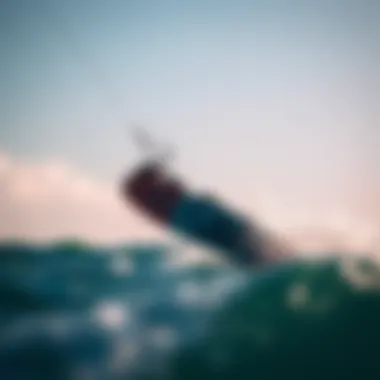
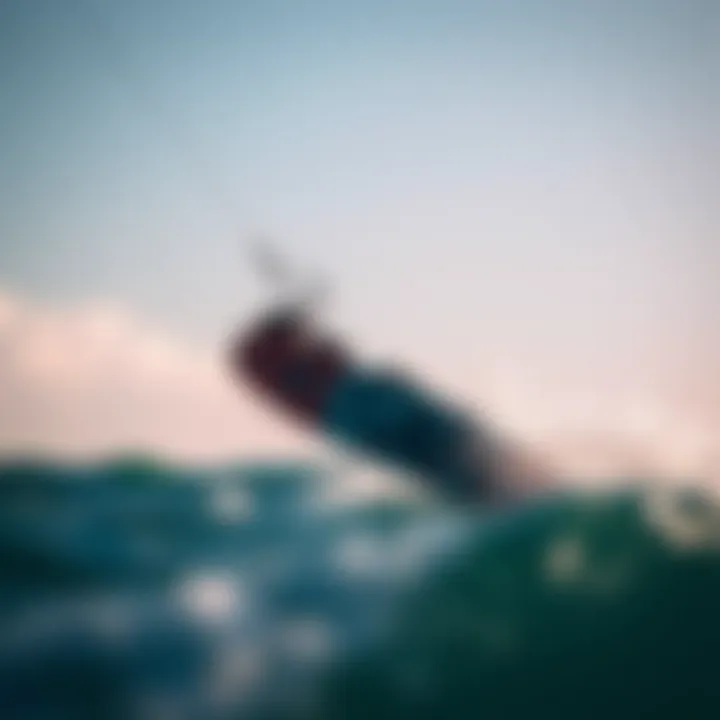
Regular Cleaning and Storage
Cleaning and storing your kitesurfing gear does more than give it a fresh look; it is a crucial step in preserving its integrity. Every time you come off the water, a good rinse is in order. Salt, sand, and debris can accumulate and damage the fabric and hardware of your gear.
- Rinse with Fresh Water: After each session, thoroughly rinse your kite and board with fresh water to remove salt and sand. This quick process will help maintain the material and eliminating grime buildup.
- Dry Completely: Lay your gear flat on a non-abrasive surface to dry. Avoid direct sunlight as it can weaken the fabric over time. Proper drying ensures that mildew doesn't become a problem later.
- Store Properly: Once your gear is clean and dry, store it in a cool, dry place. Avoid rolling your kite tightly; it's better to store it flat to prevent creasing and potential wear on stress points.
Taking the time to clean and store your equipment well helps it last significantly longer. As they say, "A stitch in time saves nine," and that rings true for kitesurfing gear as well.
Inspecting for Wear and Tear
Regular inspections are a must for used kitesurfing equipment. Over time, even the best care can’t completely prevent wear and tear from use. During these checks, you'll want to pay attention to several key aspects:
- Kite Fabric and Seams: Look for frays, tears, or areas where the fabric has become thin. Checking the seams is crucial since this is where most rips occur. If you see loose stitching, it might be time for a repair.
- Board Surface: A close look at the edges and bottom of your board can reveal dings or scratches. If you notice significant damage, your board might require repair to maintain performance and safety on the water.
- Harness and Bar Components: Functionality of the harness and bar should not be neglected. Check the straps on your harness for wear and ensure that any buckles work smoothly. For the bar, inspect the lines and safety leash for any frays or deterioration.
Given that kitesurfing can take you into rigorous conditions, a proactive approach to checking your gear can prevent small issues from becoming big problems down the line.
Repairing Minor Damage
When it comes to kitesurfing equipment, a few minutes spent on repairs can save both time and money. Learning basic repair skills can make a significant difference in your gear’s lifespan and your experience on the water.
- Patching Kite Tears: If you discover a small tear, using a dedicated fabric patching kit can be effective. Ensure both the patch and the fabric are clean before applying adhesive. Let the patch set according to the instructions for the best hold.
- Board Repairs: For minor dings on your board, you can use epoxy to fill in cracks. Sand the area around the damage for good adherence before applying the epoxy, and once it’s dry, sand it flush to maintain the board's proper surface.
- Line Replacements: If you find the lines on your kite beginning to fray, don't hesitate to replace them. Used lines should be replaced if you see significant signs of wear. This will not only keep your sessions safe but also improve your gear’s performance overall.
Remember, addressing minor repairs early allows you to skip the headache of more extensive fixes later on, keeping those kitesurfing sessions coming non-stop.
"An ounce of prevention is worth a pound of cure." Taking these steps in maintaining your equipment can greatly enhance both its lifespan and your kitesurfing adventures.
Market Trends in Kitesurfing Equipment
Understanding market trends in kitesurfing gear is crucial for anyone looking to make informed purchasing decisions, especially when considering used equipment. The landscape of kitesurfing is ever-evolving, influenced by advancements in technology, shifting consumer habits, and the pervasive role of social media. Acknowledging these trends not only aids buyers in selecting the right gear but also ensures that they remain competitive and safe on the water.
Emerging Technologies
In recent years, kitesurfing equipment has seen significant technological advancements. Materials have improved, resulting in lighter and more durable kites and boards. For instance, manufacturers are using ripstop fabrics that are less likely to tear, giving kites longer lifespans. Nowadays, many boards feature unique construction techniques like carbon fiber reinforcement, which enhances performance without adding extra weight. As a potential buyer, understanding these innovations allows you to assess whether used equipment has integrated any of these technologies. Some technologies that stand out include:
- Inflatable kites with improved internal bladder designs that enhance buoyancy and stability.
- High-performance boards with customizable flex options, adapting to different riding styles.
- Smart technology embedded in certain models, enabling real-time data on wind conditions and kite performance.
Each of these innovations offers distinct advantages, potentially adding considerable value to pre-owned gear that incorporates them.
Shifts in Consumer Preferences
Trends in consumer behavior can change the game for kitesurfing enthusiasts. There's a growing awareness about sustainability, prompting many riders to opt for used or eco-friendly gear rather than brand new equipment. Price sensitivity plays a role here as well; with the increased cost of living, many are seeking ways to save without sacrificing quality. Additionally, a rise in popularity of specific brands or models can lead to a higher demand for those items in the used market. This creates shifts in availability and pricing, often favoring brands with a robust community following.
Kiteboarders now carefully consider:
- Brand loyalty, leading to an increase in second-hand items from preferred manufacturers.
- Performance reviews, as more users share their experiences online, affecting what others buy.
- Collaboration gear, where one brand partners with pro riders to offer special editions. These partnerships can create a mini-collector's market for used items once they've sold out new.
Influence of Social Media
Social media platforms have transformed how kiteboarding enthusiasts connect and share insights. From Instagram to TikTok, users are posting everything from tutorials to gear reviews. This shift has significant implications for market trends. As buyers become more informed about equipment through social channels, they often seek specific features highlighted by their favorite influencers or professional riders. Consequently, this can increase demand for certain gear, impacting its availability and price in the used market.
"Social media isn't just a place to show off; it's now a powerful tool shaping the very gears we choose!"
Given the rapid nature of social trends, it's important for kiteboarders to stay updated on what gear is currently in vogue. Information can spread like wildfire; an innovative kitesurfing setup featured by a well-known influencer may spark an immediate interest among fans. Connecting with communities on platforms like Reddit or participating in Facebook groups can also provide insights into what to look for when exploring used options.
By staying informed about these elements, kiteboarders can navigate the used equipment market more efficiently, ensuring that their choices align with contemporary trends and expectations.
Finale and Future Outlook
Navigating the world of used kitesurfing equipment necessitates a careful approach, where every decision made has its own weight. As kiteboarding enthusiasts, it is essential to recognize the vast array of choices available in the used market. Understanding the nuances of used gear not only focuses on cost savings but also highlights the opportunity to access premium brands that might otherwise be out of reach. The ongoing evolution in this segment plays a crucial role in shaping how riders like you experience the thrill of gliding over waves.
Making Informed Choices
When considering your purchase, it’s pivotal to arm yourself with information. Start by familiarizing yourself with thorough inspection techniques—knowing what to look for in kites, boards, and harnesses can empower you to navigate the used market more efficiently. It’s like knowing how to spot a rotten apple in a barrel; not every piece of used gear is created equal.
- Research Brands: Dive into specific manufacturer reputations. Some brands stand the test of time and might offer a better value in the used market.
- Ask Questions: Don’t shy away from engaging the seller. Inquire about the gear's history and any repairs made.
- Educate Yourself on Lifespans: Knowing the expected lifespan of gear can aid in determining a fair price and viability for your future activities.
By being thorough in your investigation, you can keep from stepping into a minefield of regret—a wise old adage might say, "better safe than sorry."
The Evolving Landscape of Kitesurfing Equipment
The kitesurfing industry is a dynamic space, with constant innovations shaping the equipment available for both seasoned pros and newcomers. Each year tends to bring a wave of newer designs, featuring lighter materials, enhanced performance features, and more user-friendly designs. The emergence of eco-friendly gear and sustainable practices is also a pivotal shift in today’s market. Recognizing these trends enables kiteboarders to adapt and choose gear that not only enhances performance but also aligns with personal values about sustainability.
Additionally, technological advancements are revolutionizing safety features. Innovations such as quick-release mechanisms and advanced materials offer greater reliability than in the past. The blend of evolving customer preferences and technological progress signals that it’s crucial to remain adaptable and informed about these transitions.
In the words of the wise, "change is the only constant," and keeping an eye on the horizon of kitesurfing equipment ensures you're not left in the dust as the tides shift.
Overall, understanding these elements not only fosters a more enjoyable experience on the water but also encourages a deeper appreciation for the sport and its accompanying gear.
